The Best Vegan Gingerbread Cookies for Christmas: Easy, Festive & Delicious!

The festive season brings with it a delightful array of culinary traditions, and among them, Christmas baking holds a special place in many hearts. For me, gingerbread always takes a prime spot on the holiday treat list, whether it’s in the form of a comforting ginger cake or these wonderfully spiced cookies. There’s truly nothing quite like the aroma of freshly baked gingerbread filling your home to evoke the spirit of Christmas.
This recipe for vegan gingerbread cookies is designed to be your ultimate holiday baking companion. It’s incredibly straightforward, ensuring perfect results even for novice bakers. These cookies are not only spicy and utterly delicious, but they also maintain their shape beautifully during baking, making them ideal for intricate decorating. Plus, the delightful scent that wafts through your kitchen as they bake is a bonus that everyone will appreciate.
Beyond their taste, these gingerbread cookies are incredibly versatile. They store exceptionally well, making them perfect candidates for thoughtful homemade gifts or charming edible decorations for your Christmas tree. And, of course, they’re simply wonderful to have on hand for a quick snack throughout the joyful holiday season.
While delicious on their own, a touch of icing transforms these cookies into stunning festive masterpieces. Decorating gingerbread cookies is also a fantastic activity to engage children for an hour or two – just be prepared for some wonderfully unique (and perhaps slightly messy!) artistic interpretations!

Crafting the Perfect Vegan Gingerbread Cookies: A Step-by-Step Guide
Achieving bakery-quality vegan gingerbread cookies is simpler than you might think. This recipe utilizes a unique melting method for the wet ingredients, which contributes to the cookies’ excellent texture and helps them hold their shape. Below, we’ll walk through each step, ensuring you have all the tips and tricks for success.
1. Melting the Base Ingredients
Unlike many cookie recipes that start with creaming butter and sugar, this gingerbread recipe begins by melting the foundational ingredients in a saucepan. This method creates a wonderfully smooth base and helps develop the rich, deep flavors that define classic gingerbread.
Begin by combining your vegan block butter, light brown soft sugar, golden syrup, and black treacle (also known as molasses) in a medium saucepan. Place the saucepan over a low heat. Stir continuously until all the ingredients have fully melted and are thoroughly combined into a smooth, glistening mixture. Once melted, immediately remove the pan from the heat to prevent scorching.
(Note on ingredients: The image below might show a mix of block butter and coconut oil. While you can substitute some or all of the butter with coconut oil if necessary, for the absolute best results in terms of flavor and texture, I highly recommend sticking with vegan block butter. Coconut oil can sometimes make the dough a little greasier.)
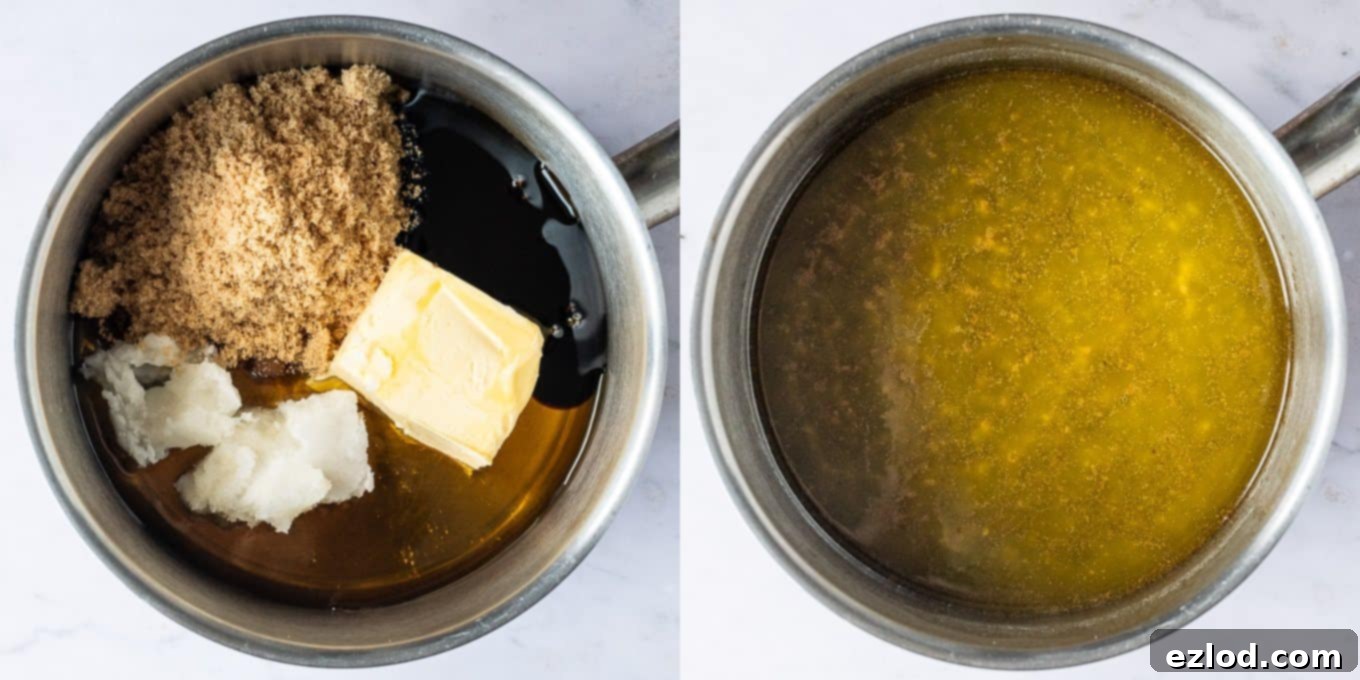
2. Infusing with Festive Spices
Once your base mixture is melted and off the heat, it’s time to introduce the aromatic heart of gingerbread: the spices. Add the ground ginger, cinnamon, cloves, allspice, and bicarbonate of soda (baking soda) to the saucepan. Whisk the mixture vigorously until it is entirely smooth and no lumps remain. You’ll notice the mixture may foam up slightly as the bicarbonate of soda reacts – this is completely normal and helps create a lovely texture in your finished cookies.
I personally prefer my gingerbread to have a strong, fiery kick, so I tend to be generous with the spice quantities. However, feel free to adjust the amounts to suit your own taste. If you prefer a milder gingerbread, simply reduce the quantity of each spice slightly.
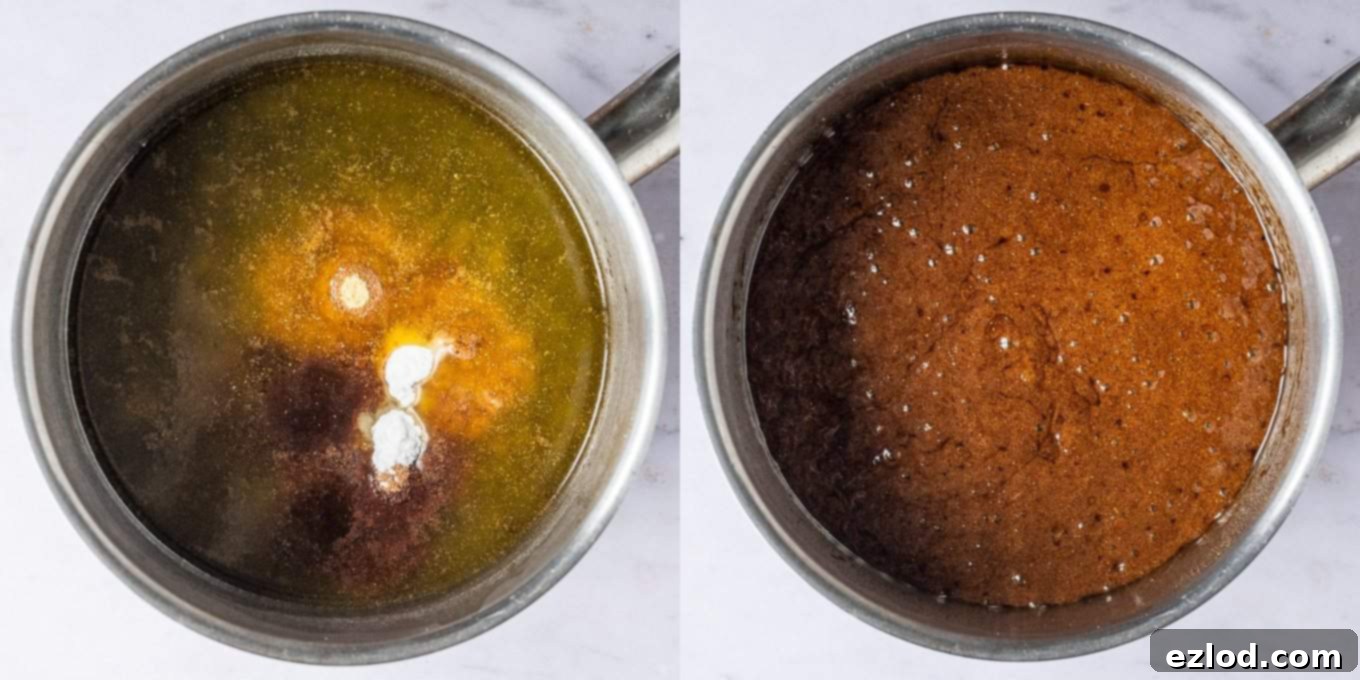
3. Bringing the Dough Together and Chilling
Now, it’s time to incorporate the dry ingredients. Add the plain (all-purpose) flour to the spiced wet mixture. Using a sturdy wooden spoon or spatula, stir diligently until all the flour is fully combined and there are no dry patches left in the dough. The dough should be soft but cohesive.
Once mixed, wrap the gingerbread dough tightly in clingfilm or an environmentally friendly alternative (a silicone Stasher bag works wonderfully). Place the wrapped dough in the refrigerator and chill it for at least a couple of hours. This chilling step is absolutely crucial; it allows the flavors to meld, the dough to firm up, and prevents the cookies from spreading excessively during baking, ensuring they hold their cut-out shapes perfectly.
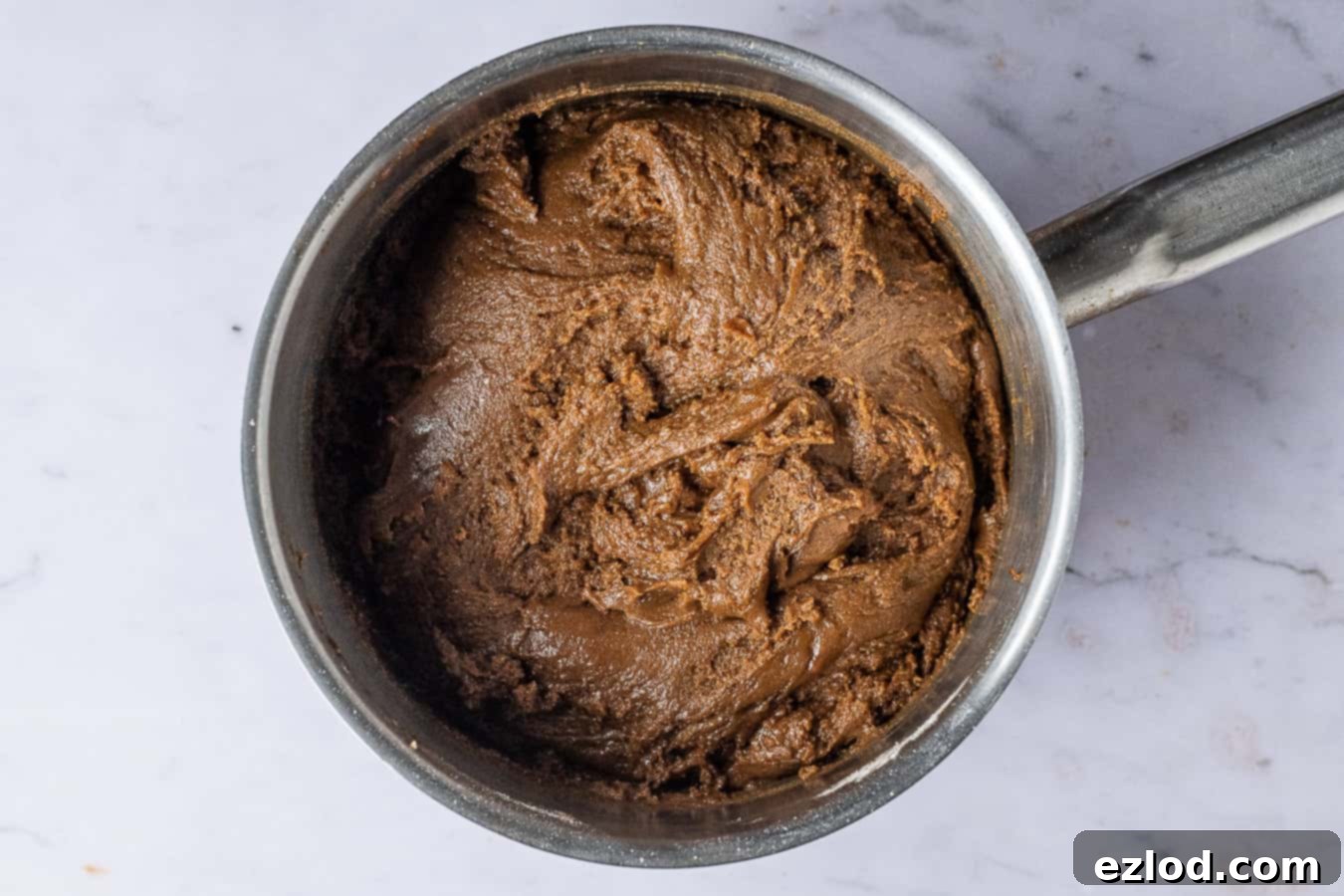
The beauty of this dough is its excellent shelf life. It can be stored in the fridge for up to two days, allowing you to prepare it in advance. If the dough has been chilling for a longer period and feels very firm, let it sit at room temperature for about 10-15 minutes before attempting to roll it out to make it more pliable.
4. Rolling and Cutting Your Cookies
Once the dough is adequately chilled, it’s ready for rolling. You can roll it out either on a lightly floured surface or, for less mess and easier handling, between two sheets of baking parchment. Roll the dough to your desired thickness, typically between 3-5mm. Thinner cookies will be crispier, while thicker ones will yield a softer, chewier result.
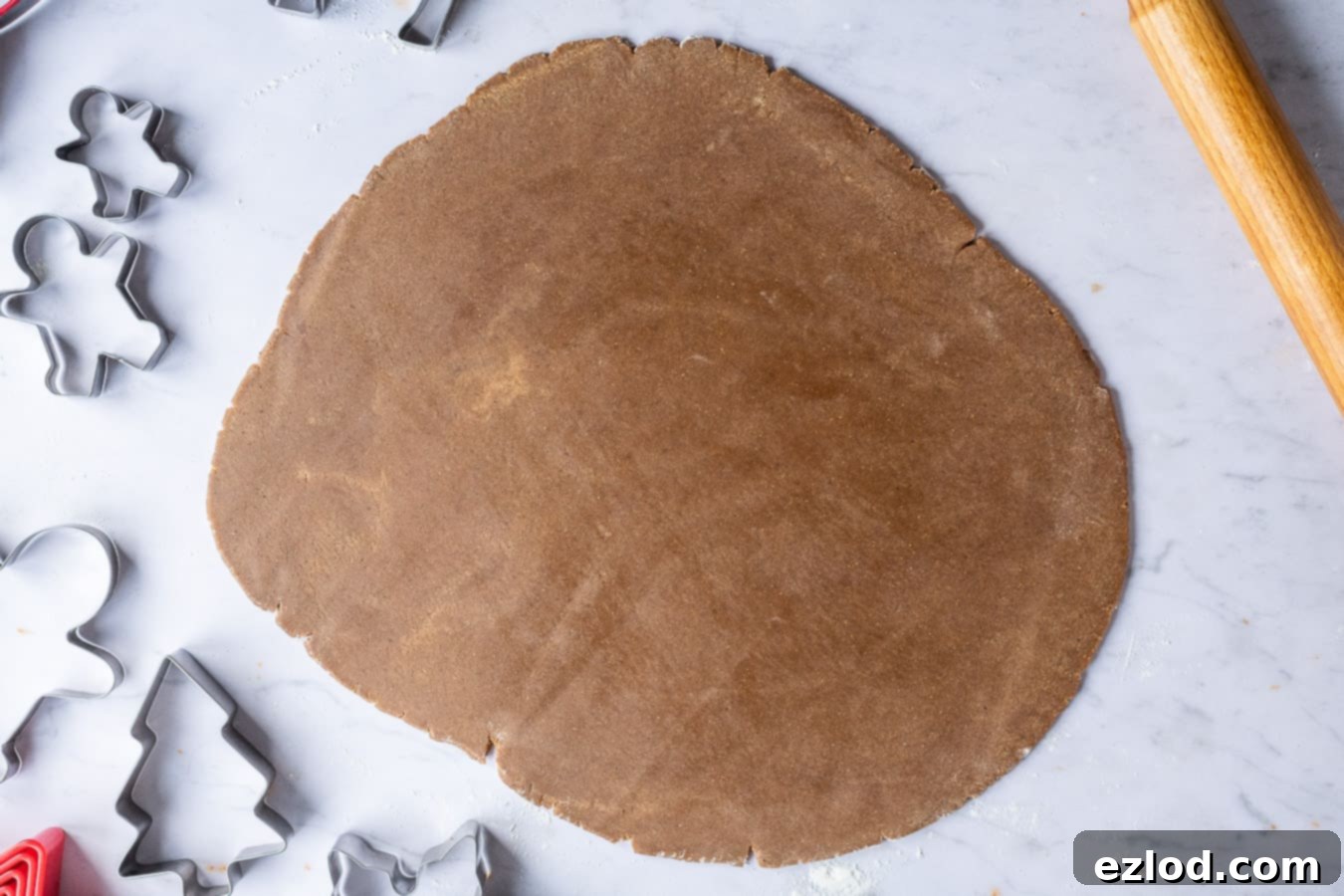
Using your favorite cookie cutters – think classic gingerbread men, festive stars, snowflakes, or any other shapes you fancy – cut out as many cookies as possible from the rolled dough. Gather any dough scraps, gently press them back into a ball, re-roll, and cut out more shapes until all the dough is used.
Carefully transfer your cut-out cookies to baking sheets lined with baking parchment, ensuring they are well-spaced. These cookies will spread slightly as they bake, so giving them enough room prevents them from sticking together.
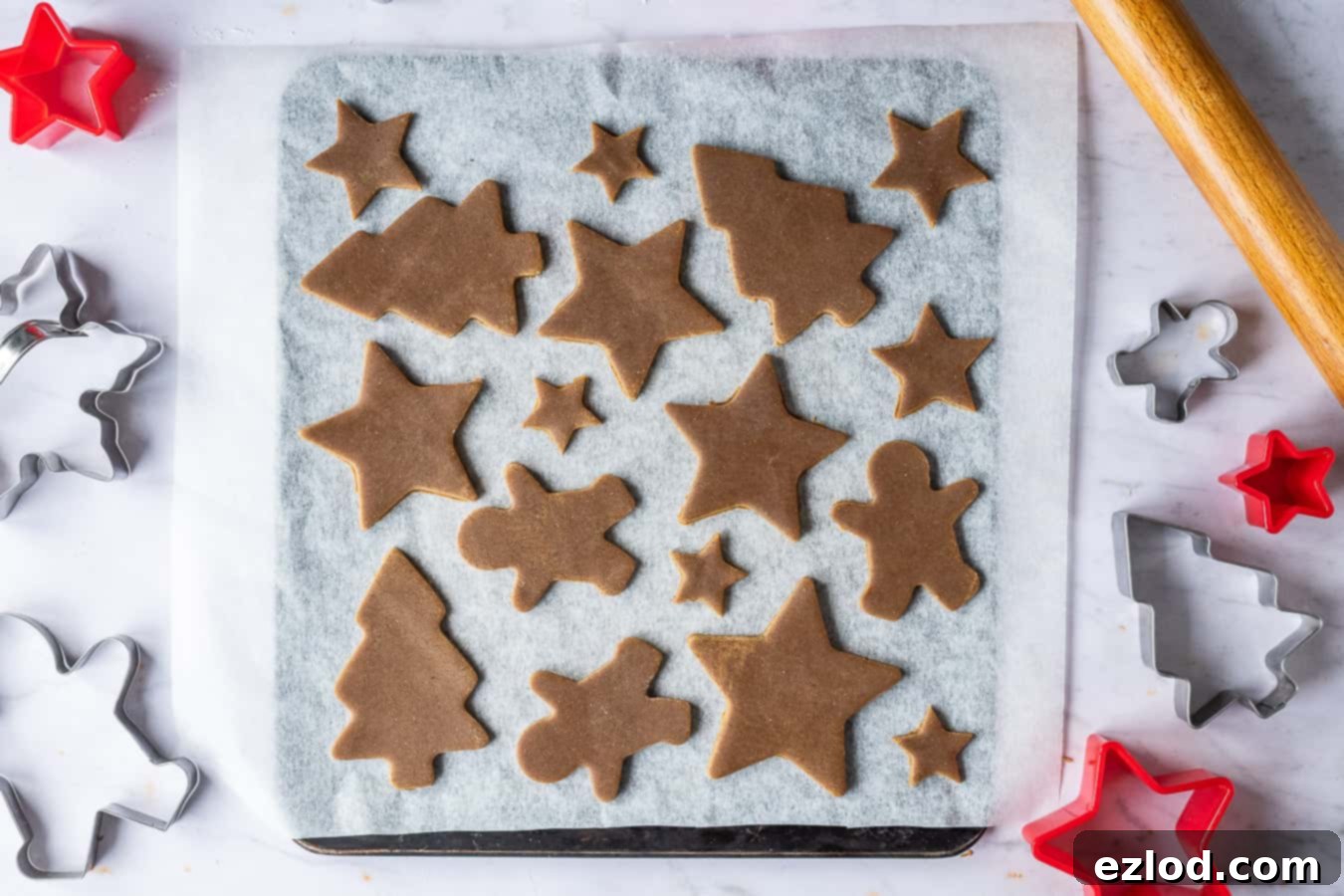
5. The Essential Pre-Bake Freeze & Baking
For cookies that truly maintain their perfect shape, do not skip this step: place the baking sheets with your cut-out cookies into the freezer for 15 minutes. This quick freeze solidifies the butter and sugar, preventing the cookies from spreading too much in the oven. While the cookies are chilling, preheat your oven to 180°C/350°F/gas mark 4.
Once frozen, transfer the trays directly to the preheated oven. Bake the cookies for 8-12 minutes. The exact baking time will depend on two factors: the size of your cookies (smaller ones will cook faster) and your preferred texture (shorter baking for soft cookies, longer for crunchy). I usually bake mine until they just begin to brown delicately around the edges. They will still feel quite soft when you remove them from the oven, but they will firm up beautifully as they cool.
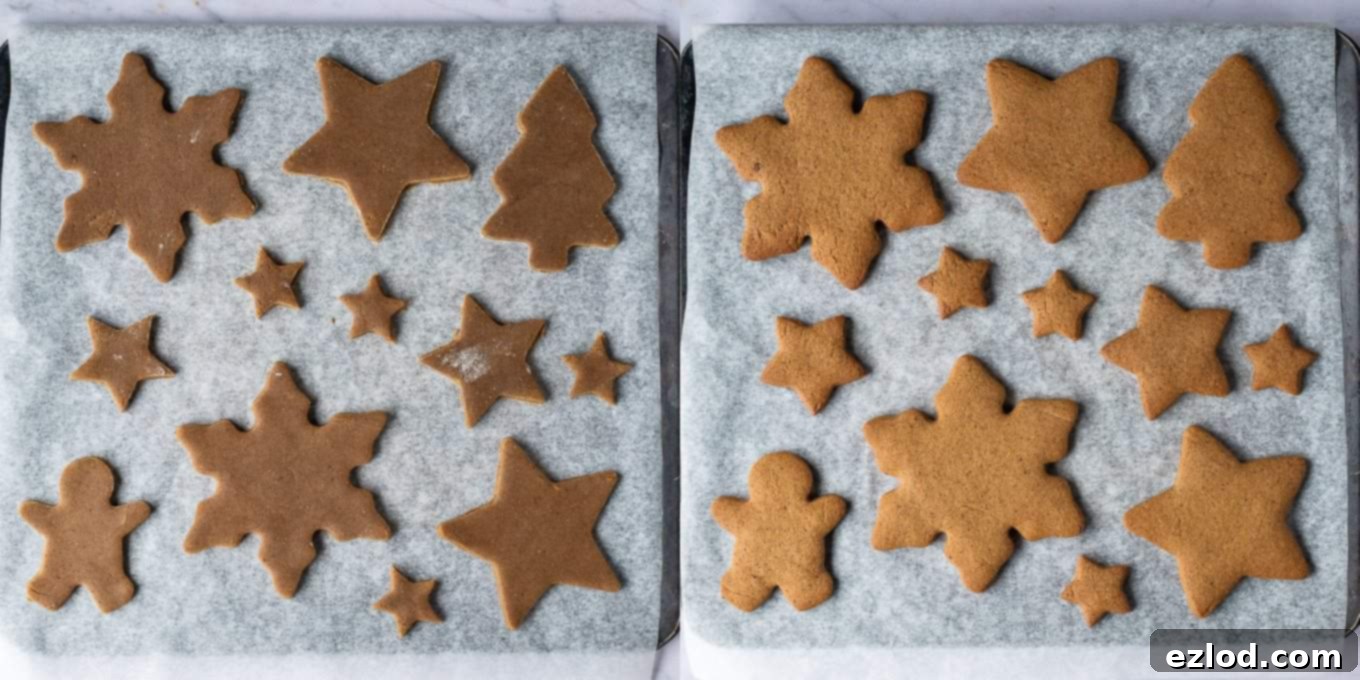
6. Cooling and Decorating with Vegan Royal Icing
After baking, allow the cookies to cool on the baking trays for a few minutes. They will be delicate when hot. Once they’ve firmed up slightly, carefully transfer them to a wire rack to cool completely. This ensures proper air circulation and prevents them from becoming soggy.
Once the cookies are thoroughly cold, it’s time to prepare the vegan royal icing. In a bowl, combine sifted icing (powdered) sugar, lemon juice, and aquafaba (the liquid from a can of chickpeas, which acts as a fantastic egg white substitute). Stir until the icing is thick but still pourable. A good test for consistency is to drizzle a small amount back into the bowl; if the pattern disappears after about 10 seconds, it’s perfect. If it’s too thick, add a tiny drop more lemon juice; if too runny, gradually add more sifted icing sugar.
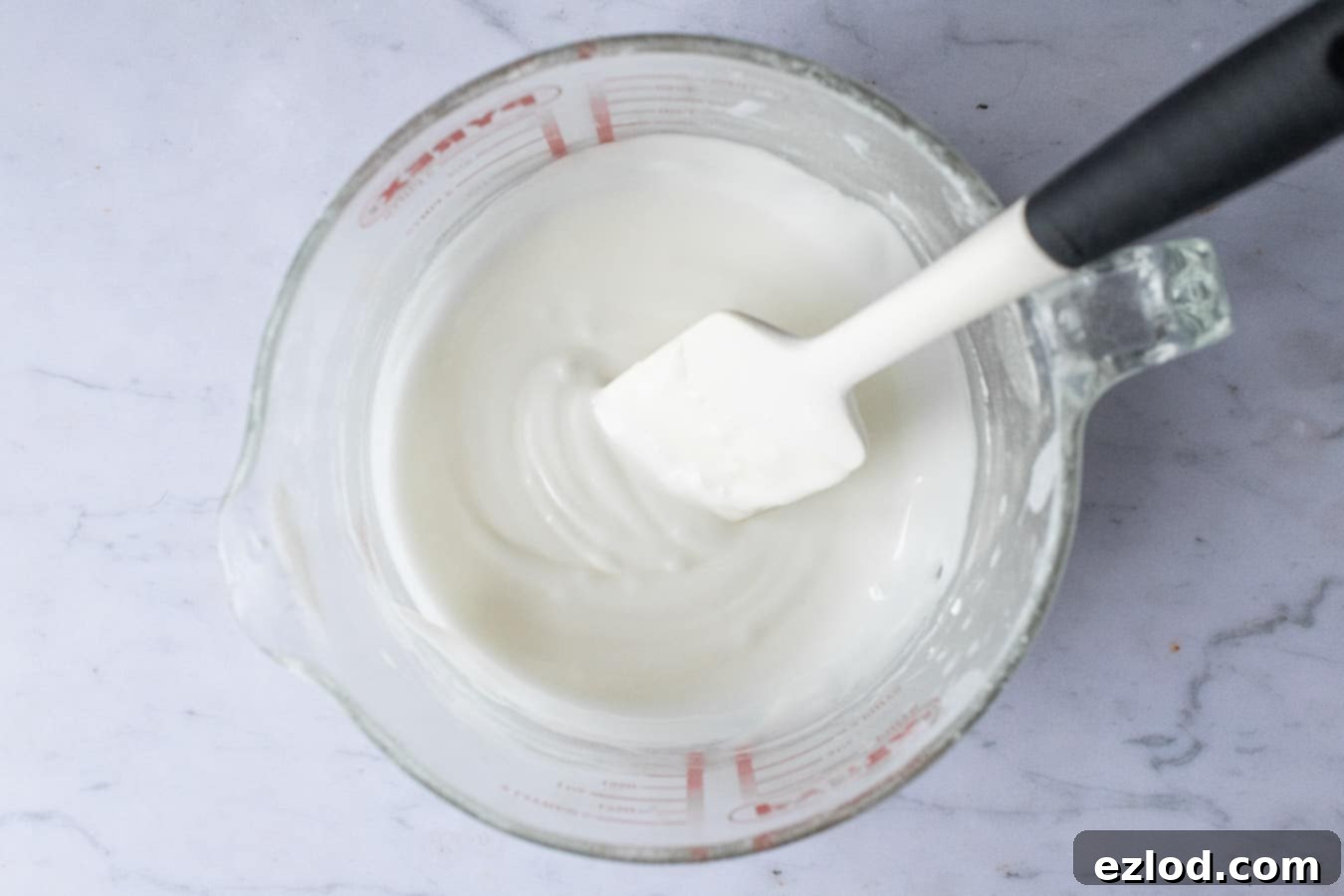
Transfer the prepared icing to a piping bag fitted with a small round writing nozzle. Now, let your creativity shine! Decorate your gingerbread cookies as elaborately or simply as you wish.
After decorating, leave the iced cookies to dry flat for at least a couple of hours. This allows the royal icing to set and harden, preventing smudges before you store them in an airtight container.

Top Tips for Vegan Gingerbread Cookie Success
Baking is often a science, and a few key practices can elevate your results from good to absolutely perfect. Here are some essential tips to ensure your vegan gingerbread cookies turn out beautifully every time:
- Precision in Measurement: As with all my baking recipes, I cannot stress enough the importance of using metric measurements with a digital scale rather than cup conversions. Volume measurements (cups) are inherently inaccurate for baking and can lead to inconsistent results. A digital scale ensures precise ingredient ratios, leading to reliably perfect cookies and often less mess!
- Patience with Chilling: The dough absolutely needs to chill for at least a couple of hours before rolling. This isn’t just a suggestion; it’s a crucial step that allows the dough to firm up, preventing the cookies from spreading too much in the oven and helping them maintain their crisp, clean shapes. It also allows the spices to fully hydrate and meld with the other ingredients, deepening the flavor.
- The Right Vegan Butter: For baking, you MUST use a solid block-style vegan butter or margarine, not the spreadable type that comes in a tub. Spreadable margarines contain a higher water content, which can negatively impact the dough’s texture and cause the cookies to spread excessively. Reputable brands like Naturli Vegan Block, Stork or Vitalite block, Tormor, or Earth Balance Buttery Sticks are excellent choices.
- Coconut Oil as an Alternative: If vegan block butter is unavailable, you can substitute it with coconut oil, or even use a combination of both. Be aware that using coconut oil might make the dough feel a bit greasier to handle, but the baked cookies will still turn out delicious.
- Accuracy with Syrups: Golden syrup and black treacle (molasses) are key to the gingerbread’s unique flavor and texture. It’s vital to weigh these accurately. Even a difference of a few grams can subtly alter the dough’s consistency and how the cookies behave during baking.
- Golden Syrup Substitutes (US Specific): If you’re in the US and can’t find golden syrup (check the international foods aisle or online!), a good substitute is light molasses. Ensure it’s *light* molasses, not blackstrap molasses, which has a much stronger, more bitter flavor that isn’t suitable for this recipe.
- Adjusting Spice Levels: My recipe uses a generous amount of spices for a “fiery” gingerbread. If you prefer a milder flavor, feel free to reduce the quantities of ground ginger, cinnamon, cloves, and allspice to your personal taste.
- The Freezer Trick: Freezing the cut-out cookies for 15 minutes before baking is a simple yet powerful technique to help them retain their sharp edges and intricate shapes. Don’t skip this step for beautifully defined cookies.
- Soft vs. Crunchy Cookies: The desired texture of your gingerbread cookies is easily controlled by baking time. For softer, chewier cookies, bake them for a shorter duration (closer to 8 minutes). For crispier, crunchier gingerbread, extend the baking time (closer to 12 minutes).
- Test Baking: Ovens vary, and cookie cutter sizes differ. To find the perfect baking time for your specific oven and desired texture, I highly recommend baking a couple of test cookies first. This small step can save your entire batch from being over or underbaked.
- Aquafaba Alternatives for Icing: If you prefer not to use aquafaba in your royal icing, you can simply substitute it with an equal amount of additional lemon juice or water.
- Coloring Icing: For vibrant colored icing, use gel food colors. Liquid food colors can alter the consistency of the icing too much. Many gel food coloring brands are vegan-friendly; Sugarflair is generally considered safe.

What Is A Substitute For Golden Syrup?
Golden syrup is a beloved baking staple in the UK, renowned for its distinct buttery caramel flavor and a consistency similar to honey. The good news is that Lyle’s Golden Syrup, a popular brand, is vegan-friendly. While it can sometimes be a bit challenging to find outside the UK, many international food sections in larger US supermarkets now carry it, or you can easily purchase it online. For the adventurous baker, you can even make your own golden syrup at home!
If you’re unable to source golden syrup, the best readily available substitutes are light molasses or corn syrup. Remember to avoid blackstrap molasses, as its strong, slightly bitter flavor profile is not ideal for this recipe.
How To Store Vegan Gingerbread Cookies:
These delightful vegan gingerbread cookies are excellent keepers! Once baked and fully cooled, they will remain fresh for 2-3 weeks when stored in an airtight container at room temperature. To prevent them from sticking or damaging their decorations, it’s a good idea to separate layers of cookies with sheets of greaseproof paper. Just ensure any icing or decorations are completely dry and set before stacking them.
Can I Freeze The Dough?
Absolutely! Preparing the dough in advance and freezing it is a fantastic time-saver during the busy holiday season. Once the dough is mixed, ensure it’s wrapped very well in clingfilm or placed in a freezer-safe bag to prevent freezer burn. It can be frozen for up to a month. When you’re ready to bake, transfer the frozen dough to the refrigerator to defrost overnight. Before rolling, let it come up to room temperature for a bit to make it easier to handle.
How Long Will The Dough Keep In The Fridge?
The prepared gingerbread dough is quite forgiving and can be stored in the refrigerator for up to three days. Wrap it snugly in clingfilm or place it in a sealed silicone bag. Similar to defrosted dough, if it has become very firm in the fridge, allow it to sit out at room temperature for about 10-15 minutes before rolling to ensure it’s pliable enough to work with.

More Delicious Vegan Christmas Recipes:
- Vegan Mince Pies
- Vegan Christmas Cake
- Vegan Christmas Pudding
- Vegan Mincemeat Cake
- Vegan Biscotti
- Vegan Mulled Wine Brownies
- Vegan Steamed Chocolate Pudding
- Vegan Stollen
- Starry Mince Pie Tart
If you bake these wonderful vegan gingerbread cookies, we’d love to see your creations! Tag @domestic_gothess on Instagram and use the hashtag #domesticgothess.
*All images and content on Domestic Gothess are copyright protected. If you wish to share this recipe, please do so by using the provided share buttons. Do not screenshot, copy, or post the recipe or content in full.*

Vegan Gingerbread Cookies
Vegan gingerbread cookies – these perfect vegan gingerbread cookies are easy to make and ideal for decorating at Christmas. They make lovely gifts or edible decorations and can be made soft or crunchy as you prefer.
Course: Dessert, Snack
Cuisine: British
Keyword: cookies
Prep Time: 25 minutes
Cook Time: 10 minutes
Chilling Time: 2 hours 15 minutes
Servings: 20 people
Author: Domestic Gothess
Ingredients
Vegan Gingerbread Cookies:
- 150 g (½ cup + 2 Tbsp) vegan block butter (I use Naturli Vegan Block)
- 120 g (⅔ cup) light brown soft sugar
- 100 g (3 ½ oz) golden syrup
- 50 g (1 ¾ oz) black treacle (or molasses)
- 3 ½ tsp ground ginger
- 3 ½ tsp ground cinnamon
- ¼ tsp ground cloves
- ¼ tsp ground allspice
- ¾ tsp bicarbonate of soda (baking soda)
- 380 g (3 cups + 2 Tbsp) plain (all-purpose) flour (plus extra for dusting)
Vegan Royal Icing:
- 300 g (2 ½ cups) icing (powdered) sugar, sifted
- 1 Tbsp lemon juice (plus extra as needed)
- 2 Tbsp aquafaba (or use extra lemon juice or water instead)
Instructions
- Place the butter, sugar, golden syrup and treacle in a medium saucepan over a low heat and stir until melted. Remove from the heat.
- Add the ginger, cinnamon, cloves, allspice and bicarbonate of soda and whisk until smooth. The mixture will foam up a bit.
- Add the flour and stir with a wooden spoon until well combined and no dry patches of flour remain. Wrap the dough in clingfilm or an environmentally friendly alternative and refrigerate for a couple of hours until it is firm enough to roll out.
- Roll the dough out either on a lightly floured surface or between two sheets of baking parchment to about 3-5mm thick, depending on how thick you want your cookies.
- Cut out as many shapes as you can with your choice of cookie cutters. Bring the scraps together into a ball and re-roll to cut out more shapes.
- Place them well spaced apart on a couple of baking sheets lined with baking parchment. (They will spread a little as they cook so make sure they have a bit of room).
- Place the trays in the freezer for 15 minutes until firm. Meanwhile preheat the oven to 180°C/350°F/gas mark 4.
- Bake the cookies for 8-12 minutes depending on whether you want them soft or crunchy and how big they are. Little ones will cook more quickly than larger cutouts. The cookies will still be very soft but will firm up as they cool. I bake mine until they are beginning to brown around the edges.
- Leave the cookies to cool on the trays for a couple of minutes then carefully transfer them to a wire rack and leave to cool completely.
- Once the cookies are cold make the royal icing. Place the sifted icing sugar in a bowl and stir in the lemon juice and aquafaba. The icing should be thick but pourable. If you drizzle some back into the bowl the pattern should disappear after 10 seconds or so. If it is too thick stir in a drop more lemon juice, and if it is too runny add some extra sifted icing sugar.
- Transfer the icing to a piping bag fitted with a small round writing nozzle and decorate the cookies as you like.
- Leave the decorated cookies to dry flat for a couple of hours before storing in an airtight container.
Notes
- As with all of my baking recipes I really do recommend using the metric measurements with a digital scale rather than the cup conversions. Cups are a wildly inaccurate measuring system and you will get far better, more consistent results using a scale, not to mention that it is also easier and less messy than cups!
- The dough needs to chill for a couple of hours before you roll it out so make sure that you start making these gingerbread cookies early enough in the day. Alternatively, the dough can be stored in the fridge for a couple of days but you may need to let it come up to room temperature a bit before you roll it out as it gets quite firm.
- You MUST use a block butter/margarine, not the spreadable kind in a tub as it has too high a water content for baking. I use Naturli Vegan Block. Stork or Vitalite block, Tormor or Earth Balance Buttery Sticks would all work.
- You can use coconut oil instead of vegan butter, or part butter part coconut oil but the dough may feel a bit greasy. (The cookies will be fine once baked).
- Make sure that you accurately weigh out the golden syrup and treacle otherwise your cookies may spread too much. Even a difference of a few grams can affect the texture of the dough.
- If you are in the US and can’t get hold of golden syrup then you can use light molasses instead (NOT blackstrap molasses).
- Freezing the cookies before you bake them helps them to keep their shape so don’t skip this step.
- The difference between soft gingerbread cookies and crunchy ones is simply the baking time. If you want soft cookies bake them for a shorter amount of time and for crunchy ones leave them in for longer.
- As all ovens vary and the bake time will be different depending on the size of your cookie cutters and whether you want soft or crunchy cookies, I suggest baking a couple of test cookies first to figure out the perfect bake time for you.
- If you don’t want to use aquafaba in the icing you can just swap it for more lemon juice or water.
- The icing can be coloured using gel food colours (not liquid ones). I believe that Sugarflair colours are vegan friendly.

